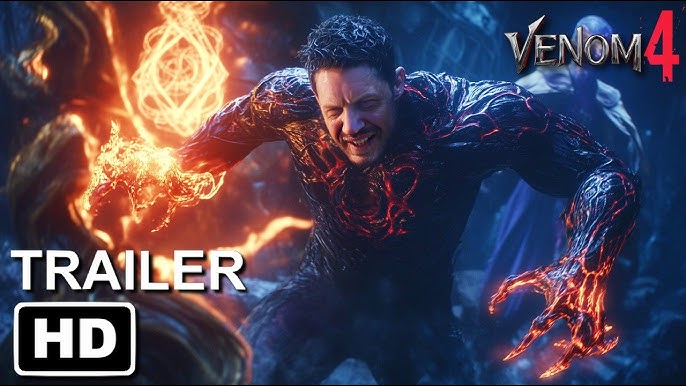In Venom 4: King in Black, the Marvel universe descends into a chaotic darkness unlike anything it has seen before. The film picks up after the cliffhanger of Venom: Let There Be Carnage and Venom 3, with Eddie Brock (Tom Hardy) struggling to balance his humanity against the monstrous alien symbiote inside him. But this time, the stakes are universal. Enter Knull — the ancient god of the symbiotes — a chilling new antagonist who emerges from the void of space, bringing with him an army of darkness bent on engulfing Earth and extinguishing all light. What follows is a high-octane cosmic horror experience that expands the Venom saga to terrifying new heights.
Venom 4: King in Black (2025)
July 11, 2025

Director Andy Serkis returns with a bolder, darker vision. The cinematography embraces a noir-toned, apocalyptic aesthetic, evoking dread and awe as symbiote dragons rain from the skies and cities fall into shadows. Hardy once again delivers a magnetic performance, deepening the duality between Eddie and Venom, this time facing a shared existential fear: the possibility that they are not the apex predators anymore. The internal struggle is matched only by the external threat, as Knull proves to be more than a typical villain—he is a force of nature, both mythic and malevolent.

The film masterfully blends action with psychological tension. Scenes of intimacy between Eddie and Anne (Michelle Williams) add emotional depth, while brief cameos from other Marvel characters — including a surprising appearance by Doctor Strange — suggest the wider multiversal implications of Knull’s invasion. What makes King in Black stand out is its refusal to play it safe. It explores themes of identity, control, and the terror of insignificance in a universe teetering on the edge of entropy. It’s darker than its predecessors but never gratuitously so; every shadow serves the story.

Visually, Venom 4 is breathtaking. The VFX team pushes boundaries, especially in sequences involving the symbiote god’s tendrils wrapping around the Earth’s atmosphere. The final battle in the ruins of New York is a cinematic spectacle — a symphony of chaos, symbiote-on-symbiote warfare, and emotional stakes that feel painfully real. Sound design plays a crucial role here too, with Knull’s voice echoing like a cosmic whisper that chills the spine. These creative choices turn the movie into more than just a superhero flick — it’s a dark sci-fi epic.

Tom Hardy’s Venom has always been messy, chaotic, and oddly lovable — and this installment solidifies him as one of Marvel’s most layered antiheroes. The bond between Eddie and Venom becomes central in this narrative, pushing the idea that strength lies not in domination, but in union. Their growth, their humor amidst horror, and their reluctant heroism make the audience root for them in the face of seemingly inevitable doom. As Knull corrupts other heroes and spreads his darkness, it becomes clear that only this odd, fractured duo can defy the void.
 By the end of Venom: King in Black, viewers are left breathless and haunted. The closing scenes hint at a potential crossover with Blade or even the Midnight Sons, teasing a new era of dark Marvel storytelling. This isn’t just a continuation — it’s a bold declaration that the Venom saga is ready to leave its own indelible mark on the cinematic universe. Fearless, feral, and ferociously fun, Venom 4 is a triumph that elevates the franchise into legend.
By the end of Venom: King in Black, viewers are left breathless and haunted. The closing scenes hint at a potential crossover with Blade or even the Midnight Sons, teasing a new era of dark Marvel storytelling. This isn’t just a continuation — it’s a bold declaration that the Venom saga is ready to leave its own indelible mark on the cinematic universe. Fearless, feral, and ferociously fun, Venom 4 is a triumph that elevates the franchise into legend.

